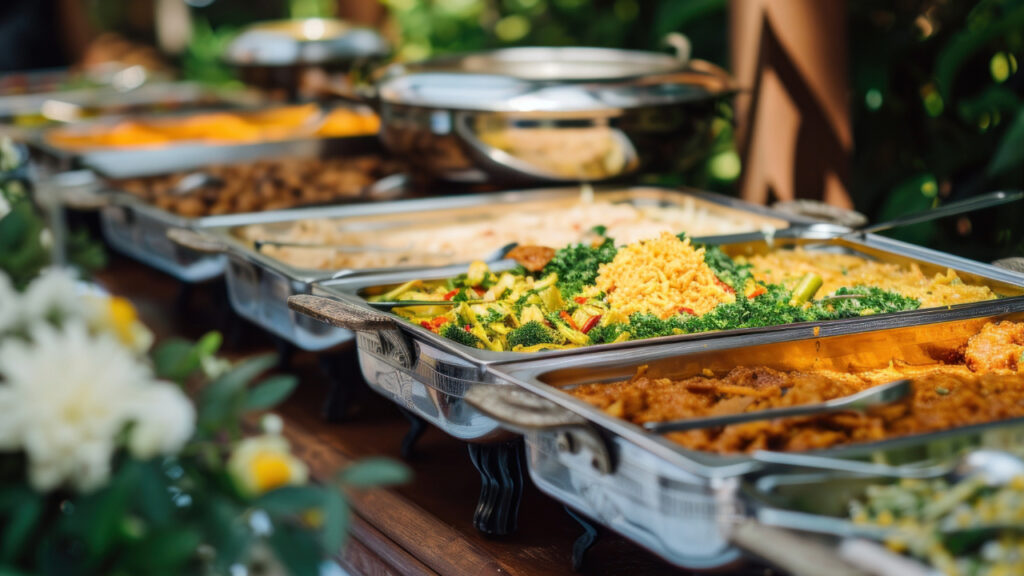Planning a wedding in Europe is like stepping into a fairy tale. The stunning venues, rich history, and incredible food and drink make for an unforgettable celebration. But let’s be real, the costs can quickly spiral out of control, especially when it comes to feeding and entertaining your guests. Don’t worry, though, we’ve got your back! With a bit of savvy planning and some insider tips, you can reduce your food and beverage costs without sacrificing quality or style. Here’s how you can have your dream European wedding and keep your budget in check.
▶️ Read also: How to organise the perfect post-wedding brunch
Pick an off-peak season or weekday for big savings
One of the most effective ways to slash your wedding catering costs is to pick an off-peak season or hold your wedding on a weekday. In Europe, the peak wedding season typically runs from late spring through early autumn, with June, July, and August being the most popular—and expensive—months to get married. Venues and caterers often charge a premium during these months due to high demand. Opting for a wedding in the quieter months, such as October through April, can lead to significant savings. Not only are the prices lower, but you might also find that vendors are more available and willing to offer discounts or extra services to secure your booking.
Weekdays are another excellent way to save. Saturdays are prime wedding real estate, and as such, they come with a hefty price tag. Consider hosting your wedding on a Friday or Sunday. Even better, a mid-week wedding can result in substantial discounts from venues and caterers who would otherwise have less business. Many of your guests may appreciate the extended weekend and the opportunity to take a mini-holiday.
To illustrate, imagine you’re planning a wedding in a popular destination like the French Riviera. Holding your wedding in January, when the region is less crowded, can mean lower rates for everything from venues to hotels. A weekday wedding at a vineyard in Tuscany might also come with the bonus of fewer tourists, allowing for a more intimate and exclusive experience.
Furthermore, off-peak weddings often benefit from more personalised attention. Vendors who are not as rushed with multiple bookings can devote more time to making your day special. You might find that florists, photographers, and caterers are more flexible with customisations and willing to include additional touches that would cost extra during the high season.
Planning around an off-peak season or choosing a weekday can also enhance the uniqueness of your wedding. Imagine a cosy winter wedding in a historic European castle, complete with roaring fires and candlelight, or a springtime weekday celebration in a charming countryside village, blooming with flowers. These settings can add a distinctive charm to your wedding, making it memorable for you and your guests.
▶️ You may like: How to plan a wedding in Europe for under $10,000
Opt for a buffet or family-style meal for a relaxed vibe and savings
When it comes to wedding receptions, the traditional plated meal is often seen as the gold standard. However, it can also be the most expensive option due to the need for more staff and the precise portions required. Instead, consider opting for a buffet or family-style meal to create a relaxed atmosphere and cut down on costs.
A buffet allows your guests to choose from a variety of dishes, catering to different tastes and dietary needs without the necessity of ordering multiple courses. This flexibility can lead to less food waste since guests can take what they want and return for more if needed. Buffets typically require fewer staff members, as guests serve themselves, which can significantly reduce labour costs.
Family-style meals, where platters of food are placed on each table for guests to serve themselves, combine the best elements of plated and buffet meals. This serving style encourages a communal dining experience, which can enhance the social aspect of your wedding reception. Like buffets, family-style meals can reduce the amount of food waste and the number of serving staff required.
For example, imagine a rustic wedding in the Italian countryside. Instead of individual plates, you could have large platters of homemade pasta, fresh salads, and regional specialties like bruschetta and cured meats delivered to each table. This approach not only cuts down on serving costs but also creates a warm, inviting atmosphere that encourages conversation and sharing among guests.
In addition to cost savings, buffets and family-style meals allow for greater menu variety. With a buffet, you can offer multiple mains, sides, and desserts, ensuring that there is something for everyone. This variety can be particularly beneficial if you have guests with diverse dietary preferences, such as vegetarians, vegans, or those with food allergies.
Another benefit is the opportunity for creative and interactive food stations. Think about adding a pasta station where guests can choose their toppings, or a carving station with different meats. These stations can act as both a meal option and an entertainment feature, making your reception more dynamic and enjoyable.

Simplify the menu to save money and showcase quality
Simplifying your wedding menu is a smart strategy to reduce costs while still offering a delightful culinary experience. By focusing on a few high-quality dishes rather than an extensive selection, you can save money and ensure that each dish is prepared with the utmost care and attention.
One of the first steps in simplifying your menu is to limit the number of courses. Instead of a multi-course meal with several starters, mains, and desserts, consider a streamlined approach with just three well-chosen courses: a starter, a main course, and a dessert. This not only reduces the cost of ingredients and preparation but also shortens the dining time, allowing more time for dancing and other festivities.
Choosing seasonal and locally sourced ingredients is another effective way to simplify your menu and cut costs. Seasonal produce is typically fresher, more flavourful, and less expensive than out-of-season items. For example, if you’re having a summer wedding in Provence, you might feature dishes with fresh tomatoes, zucchini, and herbs that are abundant during that time of year. In autumn, a wedding in Tuscany could highlight mushrooms, squash, and chestnuts.
For the main course, consider offering one or two options instead of a wide array. A perfectly roasted chicken with seasonal vegetables or a classic coq au vin can be both cost-effective and crowd-pleasing. Vegetarian options, such as a hearty ratatouille or a flavourful mushroom risotto, can also be delicious and budget-friendly.
When it comes to dessert, you don’t need to provide a lavish spread. A beautifully crafted wedding cake and a selection of seasonal fruits or a simple, elegant dessert like crème brûlée or panna cotta can suffice. This approach not only reduces costs but also allows for a more focused and memorable dining experience.
Choose local wines and beverages for a cost-effective and delightful selection
Choosing local wines and beverages is a wonderful way to enhance your wedding celebration while keeping your budget in check. Europe is home to some of the world’s most renowned wine regions, and opting for local selections can provide both financial and experiential benefits.
Local wines are typically more affordable than imported ones, as they avoid the extra costs associated with shipping and import taxes. For instance, if you’re getting married in Bordeaux, you have access to some of the finest wines at a fraction of the price you’d pay elsewhere. Similarly, a wedding in the Italian countryside can feature superb Tuscan wines that are both high-quality and budget-friendly.
Beyond wine, consider incorporating other local beverages into your celebration. In Germany, you might offer a selection of regional beers, while in Spain, a variety of local cavas and sherries can delight your guests. These local options often come with a story and heritage that can add a special touch to your wedding.
To illustrate, imagine hosting your wedding in a charming vineyard in the Loire Valley. Serving the estate’s own wines not only supports local producers but also provides a unique, personal experience for your guests. They can enjoy the same wines that grow just a few steps away, making the occasion even more memorable.
Additionally, working with local producers can lead to further customisation and collaboration. Many local wineries and breweries are open to creating personalised labels or providing special batches for your wedding, adding a bespoke element to your celebration.
Incorporating local non-alcoholic beverages is another cost-saving measure. Offer regional fruit juices, sparkling waters, or traditional drinks like French citronnade or Italian chinotto. These options can be refreshing and add a local flair without the high costs associated with imported beverages.
Consider a signature cocktail to add a personal touch and save on costs
Offering a signature cocktail is an excellent way to add a unique, personal element to your wedding while keeping beverage costs under control. Instead of stocking a full bar with a wide variety of spirits, you can limit the selection and focus on a couple of signature drinks that reflect your tastes and the theme of your wedding.
Creating a signature cocktail allows you to showcase a drink that has special meaning to you as a couple. Perhaps it’s a classic cocktail you both enjoy or a custom concoction inspired by your favourite flavours. By featuring this drink, you provide a personal touch that can make your wedding even more memorable.
For example, if you’re having a summer wedding on the Amalfi Coast, you might serve a refreshing limoncello spritz, made with local limoncello, prosecco, and a splash of soda water. This not only ties in with the local setting but also offers a delightful, cost-effective option for your guests.

Limit the open bar time
While an open bar is a generous and popular choice at weddings, it can quickly become one of the most significant expenses. To manage this cost without sacrificing your guests’ enjoyment, consider limiting the open bar time. Instead of having an open bar for the entire event, you can strategically schedule it for key moments of the celebration, such as during the cocktail hour and dinner. This approach ensures that your guests have access to complimentary drinks during the most important parts of the evening, while also keeping your budget in check.
For example, you could start with an open bar during the cocktail hour, allowing guests to enjoy a variety of beverages as they mingle and socialise before the reception officially begins. Then, extend the open bar through dinner service, providing wine and beer to complement the meal. Once dinner is over and the dancing begins, you can switch to a cash bar or offer a limited selection of drinks, such as beer, wine, and a signature cocktail. This strategy not only reduces costs but also helps to moderate consumption, ensuring that your guests can enjoy the festivities responsibly.
DIY desserts and cake to add a personal touch and save money
Creating your own desserts and wedding cake can be a fantastic way to add a personal touch to your wedding while also saving a significant amount of money. If you or someone in your circle has a talent for baking, DIY desserts can not only be budget-friendly but also incredibly meaningful. Homemade treats often carry a special sentiment, making them a delightful addition to your celebration. You could even turn the baking process into a fun pre-wedding activity with family and friends, creating memories that will last a lifetime.
For example, consider baking a smaller, beautifully decorated wedding cake for the ceremonial cutting, and supplementing it with a variety of homemade desserts for your guests. Simple yet elegant options like cupcakes, brownies, or a selection of cookies can be arranged attractively on a dessert table. These treats can be made ahead of time, reducing last-minute stress, and offering your guests a delightful array of options. Alternatively, you might opt for a rustic “naked cake” adorned with fresh fruits and flowers, which can be less intimidating to bake and decorate than a traditional, multi-tiered cake.
Reduce food waste to save money and support sustainability
Reducing food waste is a crucial consideration that can help you save money and make your wedding more sustainable. To start, work closely with your caterer to estimate the right amount of food based on your guest count and their eating habits. Experienced caterers can offer valuable insights into portion sizes and popular menu items, ensuring that you order just the right amount of food without overestimating. This not only helps cut costs but also ensures that less food goes to waste.
For example, you might opt for smaller portions of high-quality dishes rather than large quantities of multiple items. Offering a limited but well-curated menu can help manage costs and waste effectively. Additionally, consider implementing a RSVP system where guests can choose their meal preferences in advance. This allows you to tailor the food quantities more accurately, ensuring that each dish is prepared for the correct number of people, reducing the likelihood of leftovers.
Another strategy is to repurpose leftovers creatively. Work with your caterer to plan for any surplus food to be packaged and offered to guests as they leave. This could be in the form of late-night snack boxes or next-day brunch items. Moreover, you can arrange for leftover food to be donated to local shelters or food banks. This not only supports your community but also gives purpose to the food that might otherwise go to waste.
To conclude, reducing food and beverage costs at your European wedding is achievable with thoughtful planning and creative solutions. By considering the season and day, opting for alternative serving styles, simplifying your menu, and choosing local options, you can create a memorable and cost-effective dining experience. Collaborating with local vendors and incorporating personal touches further enhances the celebration without breaking the bank. With these strategies, you can enjoy a beautiful, delicious, and budget-friendly wedding in Europe.






